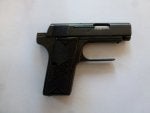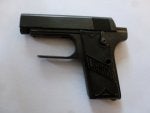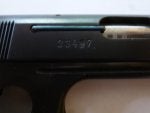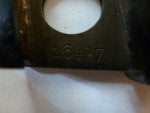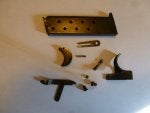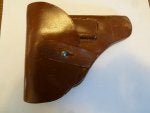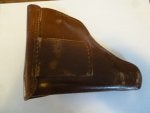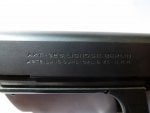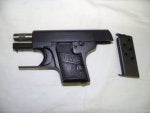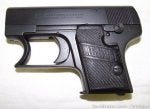Friends,
Over the past couple of years I have been compiling serial number data on many of the vest pocket pistols produced between the years 1903 and 1950. I thought I would begin organizing and presenting some of it, as it may be of interest to a few of the members here who are enthusiasts of these little guns.
The Lignose (and earlier Bergmann) pocket pistols I have found especially rewarding to research, as they seem to have a fairly high survival rate. The fact that there were 4 different models apparently numbered in the same series, coupled with the variations within those models, makes much food for thought and investigation.
Presented here is a list of recorded serial numbers of Bergmann and Lignose models 2, 2A, 3 and 3A, with any pertinent (in my opinion) information noted next to the gun's serial number. I welcome any input, whether hard data or opinion and observations, from fellow members. If you own a Bergmann or Lignose model 2, 2A, 3 or 3A, or have reliable information about one, please look at my list and see if it is already there. If not, please post it and I'll add it to the list.
Moderators: Please do not make this a sticky - I will be updating the list from time to time and it will get bumped that way. It's just that the forums get hard to read when there are too many stickies clumped at the top. Here is my data so far:
_____________________________________________
Bergmann-marked guns, with Bergmann-logo grips unless otherwise noted. Grip material is specified since these guns have been noted with both plastic and wood factory grips.
54, Model 3 (wood grips)
82, Model 3A, (plastic grips, steel cocking piece)
1430, Model 2 (plastic grips, marked "MADE IN GERMANY" on right side of slide)
1588, Model 2 (plastic grips, mag appears nickel finished or in the white?)
2890, Model 2 (plastic grips)
3139, Model 2, parts kit with missing frame. Has plastic grips and slide-mounted cocking indicator. Marked "MADE IN GERMANY" on right side of slide.
3547, Model 2 (plastic grips)
3914, Model 2 (wood grips)
4140, Model 2 (plastic grips, slide blank except for serial number, which is located Lignose-style)
5951, Model 3 (plastic grips)
6348, Model 2 (plastic grips)
_____________________________________________
Lignose-marked guns, with Lignose-logo grips unless otherwise noted.
6900, Model 2 (Bergmann grips)
7770, Model 3A (Bergmann grips, brass cocking piece)
8371, Model 2
8397, Model 2 (Bergmann grips)
8643, Model 3A (Bergmann grips, brass cocking piece)
8757, Model 3A (Bergmann grips, brass cocking piece)
9072, Model 2 (marked "GERMANY" on right rear frame)
9223, Model 2 (marked "GERMANY" on left side of trigger guard)
9493, Model 2 (marked "GERMANY" on right rear frame)
9495, Model 2 (marked "GERMANY" on the upper left side of the trigger guard, where it joins the frame)
9584, Model 2
9739, Model 2 (Bergmann grips), marked "GERMANY" on the left side of slide, near front
9790, Model 2
10105, Model 2 (Bergmann grips), marked "GERMANY" on left side of slide, near front
10365, Model 2 (Bergmann grips)
10527, Model 2
10557, Model 2
10873, Model 2
11071, Model 2A (brass cocking piece)
11254, Model 2
11353, Model 2A or 3A, undetermined (only the slide observed)
11567, Model 2A (brass cocking piece)
11881, Model 2A (brass cocking piece), with holster and spare magazine
12344, Model 2A (brass cocking piece)
12478, Model 2A (brass cocking piece, Czech proofed 2668.26)
12579, Model 3
13016, Model 2A (brass cocking piece)
13235, Model 2A (brass cocking piece)
13378, Model 3A (brass cocking piece), seller says it is refinished
13394, Model 3A (brass cocking piece)
13466, Model 2A (brass cocking piece)
14678, Model 3A (brass cocking piece)
14818, Model 2
14894, Model 2
15064, Model 3A (brass cocking piece)
15075, Model 3A (brass cocking piece)
15720, Model 3A (brass cocking piece)
15741, Model 3A (brass cocking piece)
15757, Model 3A (brass cocking piece)
16072, Model 3 (logo has been smeared off both grips)
16228, Model 3
16848, Model 3
16865, Model 3, fully relief-engraved in ornamental scroll pattern on punched background. Silver plated with ivory grips. Gold-plated trigger, safety, magazine, magazine catch and barrel (according to auction description). Grip screws replaced.
17234, Model 3
18258, Model 2, with holster
18411, Model 2
18461, Model 3A (completely refinished in nickel, wood replacement left grip)
18946, Model 3A (brass cocking piece)
19100, Model 2
19228, Model 3A (cocking piece missing)
19823, Model 2A (brass cocking piece)
20126, Model 3 (with holster, marked "Der orginal knopf" around the outer clasp and the button itself is marked "D.R.P. No. 408806)
20501, Model 2A (brass cocking piece)
20721, Model 2A (brass cocking piece)
20984, Model 2
21036, Model 2
21065, Model 2
21200, Model 3
21427, Model 2
21791, Model 2A (brass cocking piece, rest of gun is refinished in nickel)
21861, Model 2A (brass cocking piece)
22104, Model 2A (nickel-plated brass cocking piece, nickel-plated trigger, magazine missing)
22148, Model 2A (nickel-plated brass cocking piece, nickel-plated trigger and nickel-plated magazine)
22279, Model 2A (brass cocking piece)
22323, Model 2A (brass cocking piece)
22712, Model 2A (cocking piece missing and bottom of trigger guard ground back)
22720, Model 2A (brass cocking piece)
22778, Model 2A, nickel-plated trigger and cocking piece, blue magazine, slide appears blank with no markings
23002, Model 2A, appears fully nickeled, finish originality uncertain
23318, Model 2
23351, Model 3A (brass cocking piece)
23497, Model 3A
24510, Model 2A
24788, Model 2A
24811, Model 2A
25144, Model 2
26056, Model 3
26547, Model 2A
26616, Model 2A
26625, Model 2A
27150, Model 2A, grips chipped on both sides
28127, Model 2A
28564, Model 2A
29123, Model 2
29624, Model 2A
29968, Model 2A
30009, Model 2A
30107, Model 2A
30187, Model 2A
31015, Model 3A
31119, Model 3A
31198, Model 3A
31210, Model 3A
31265, Model 3A
31664, Model 3A
31725, Model 3A
31840, Model 3A, nickel finish (originality uncertain)
32152, Model 3A
32482, Model 2
33228, Model 3A
33326, Model 3A, light scroll engraving framing the slide legend, accompanied by cleaning supplies in metal Lignose tin
33548, Model 2A (wood grips)
33974, Model 2, with holster
34583, Model 2A
34647, Model 2A
34731, Model 2A
34893, Model 2A
35366, Model 2A
35661, Model 2
35723, Model 2
36979, Model 3A
37283, Model 3A
37293, Model 3A (missing the cocking piece; trigger guard bottom has been reformed into an enclosed guard)
38128, Model 3A
38404, Model 3A
38690, Model 3A, some parts missing
39705, Model 2A
39942, Model 2A
40037, Model 2A
40813, Model 2A
41200, Model 2A
41526, Model 3A
41755, Model 3A
42194, Model 3A
42231, Model 3A
42310, Model 3A
42478, Model 3A (Austrian proofed 2239.27)
42495, Model 3A
42562, Model 3A
42574, Model 3A
42581, Model 3A
42586, Model 3A
42595, Model 3A
42734, Model 3A
42788, Model 3A
42830, Model 3A
42848, Model 3A (wood grips)
42855, Model 3A
42862, Model 3A, slide, barrel and cocking piece only (Model identification by seller)
42863, Model 3A
42876, Model 3A
42914, Model 3A
42918, Model 3A
43012, Model 2A (wood grips)
44170, Model 2A
44344, Model 2A
44703, Model 3A
44757, Model 2A
45340, Model 2A
45747, Model 3A
45933, Model 2A
46195, Model 2A
46803, Model 3A
47047, Model 3A
47304, Model 3A
47318, Model 3A, checkered wooden grips (do not appear original)
47373, Model 3A
47622, Model 3A
47771, Model 2A
48009, Model 3A, wooden grips
48271, Model 2A
48478, Model 3A, wooden grips
48700, Model 2A
48983, Model 2A
49153, Model 2A
49235, Model 2A
49318, Model 2A
49435, Model 2A
49866, Model 2A
49894, Model 2A
49949, Model 2A
50047, Model 2A
50706, Model 2A
50942, Model 2A
51026, Model 2A
51321, Model 2A
51983, Model 2A (nickel finish, original according to owner)
52065, Model 2A
52243, Model 2A
52374, Model 3A
52555, Model 3A
52575, Model 3A
52656, Model 3A, with original maroon box and extra magazine
52736, Model 3A
52868, Model 3A
53706, Model 3A
53728, Model 3
53875, Model 2
53974, Model 3A
54120, Model 2, with holster and extra magazine
54143, Model 2
54524, Model 3A
54781, Model 2
54882, Model 3
Over the past couple of years I have been compiling serial number data on many of the vest pocket pistols produced between the years 1903 and 1950. I thought I would begin organizing and presenting some of it, as it may be of interest to a few of the members here who are enthusiasts of these little guns.
The Lignose (and earlier Bergmann) pocket pistols I have found especially rewarding to research, as they seem to have a fairly high survival rate. The fact that there were 4 different models apparently numbered in the same series, coupled with the variations within those models, makes much food for thought and investigation.
Presented here is a list of recorded serial numbers of Bergmann and Lignose models 2, 2A, 3 and 3A, with any pertinent (in my opinion) information noted next to the gun's serial number. I welcome any input, whether hard data or opinion and observations, from fellow members. If you own a Bergmann or Lignose model 2, 2A, 3 or 3A, or have reliable information about one, please look at my list and see if it is already there. If not, please post it and I'll add it to the list.
Moderators: Please do not make this a sticky - I will be updating the list from time to time and it will get bumped that way. It's just that the forums get hard to read when there are too many stickies clumped at the top. Here is my data so far:
_____________________________________________
Bergmann-marked guns, with Bergmann-logo grips unless otherwise noted. Grip material is specified since these guns have been noted with both plastic and wood factory grips.
54, Model 3 (wood grips)
82, Model 3A, (plastic grips, steel cocking piece)
1430, Model 2 (plastic grips, marked "MADE IN GERMANY" on right side of slide)
1588, Model 2 (plastic grips, mag appears nickel finished or in the white?)
2890, Model 2 (plastic grips)
3139, Model 2, parts kit with missing frame. Has plastic grips and slide-mounted cocking indicator. Marked "MADE IN GERMANY" on right side of slide.
3547, Model 2 (plastic grips)
3914, Model 2 (wood grips)
4140, Model 2 (plastic grips, slide blank except for serial number, which is located Lignose-style)
5951, Model 3 (plastic grips)
6348, Model 2 (plastic grips)
_____________________________________________
Lignose-marked guns, with Lignose-logo grips unless otherwise noted.
6900, Model 2 (Bergmann grips)
7770, Model 3A (Bergmann grips, brass cocking piece)
8371, Model 2
8397, Model 2 (Bergmann grips)
8643, Model 3A (Bergmann grips, brass cocking piece)
8757, Model 3A (Bergmann grips, brass cocking piece)
9072, Model 2 (marked "GERMANY" on right rear frame)
9223, Model 2 (marked "GERMANY" on left side of trigger guard)
9493, Model 2 (marked "GERMANY" on right rear frame)
9495, Model 2 (marked "GERMANY" on the upper left side of the trigger guard, where it joins the frame)
9584, Model 2
9739, Model 2 (Bergmann grips), marked "GERMANY" on the left side of slide, near front
9790, Model 2
10105, Model 2 (Bergmann grips), marked "GERMANY" on left side of slide, near front
10365, Model 2 (Bergmann grips)
10527, Model 2
10557, Model 2
10873, Model 2
11071, Model 2A (brass cocking piece)
11254, Model 2
11353, Model 2A or 3A, undetermined (only the slide observed)
11567, Model 2A (brass cocking piece)
11881, Model 2A (brass cocking piece), with holster and spare magazine
12344, Model 2A (brass cocking piece)
12478, Model 2A (brass cocking piece, Czech proofed 2668.26)
12579, Model 3
13016, Model 2A (brass cocking piece)
13235, Model 2A (brass cocking piece)
13378, Model 3A (brass cocking piece), seller says it is refinished
13394, Model 3A (brass cocking piece)
13466, Model 2A (brass cocking piece)
14678, Model 3A (brass cocking piece)
14818, Model 2
14894, Model 2
15064, Model 3A (brass cocking piece)
15075, Model 3A (brass cocking piece)
15720, Model 3A (brass cocking piece)
15741, Model 3A (brass cocking piece)
15757, Model 3A (brass cocking piece)
16072, Model 3 (logo has been smeared off both grips)
16228, Model 3
16848, Model 3
16865, Model 3, fully relief-engraved in ornamental scroll pattern on punched background. Silver plated with ivory grips. Gold-plated trigger, safety, magazine, magazine catch and barrel (according to auction description). Grip screws replaced.
17234, Model 3
18258, Model 2, with holster
18411, Model 2
18461, Model 3A (completely refinished in nickel, wood replacement left grip)
18946, Model 3A (brass cocking piece)
19100, Model 2
19228, Model 3A (cocking piece missing)
19823, Model 2A (brass cocking piece)
20126, Model 3 (with holster, marked "Der orginal knopf" around the outer clasp and the button itself is marked "D.R.P. No. 408806)
20501, Model 2A (brass cocking piece)
20721, Model 2A (brass cocking piece)
20984, Model 2
21036, Model 2
21065, Model 2
21200, Model 3
21427, Model 2
21791, Model 2A (brass cocking piece, rest of gun is refinished in nickel)
21861, Model 2A (brass cocking piece)
22104, Model 2A (nickel-plated brass cocking piece, nickel-plated trigger, magazine missing)
22148, Model 2A (nickel-plated brass cocking piece, nickel-plated trigger and nickel-plated magazine)
22279, Model 2A (brass cocking piece)
22323, Model 2A (brass cocking piece)
22712, Model 2A (cocking piece missing and bottom of trigger guard ground back)
22720, Model 2A (brass cocking piece)
22778, Model 2A, nickel-plated trigger and cocking piece, blue magazine, slide appears blank with no markings
23002, Model 2A, appears fully nickeled, finish originality uncertain
23318, Model 2
23351, Model 3A (brass cocking piece)
23497, Model 3A
24510, Model 2A
24788, Model 2A
24811, Model 2A
25144, Model 2
26056, Model 3
26547, Model 2A
26616, Model 2A
26625, Model 2A
27150, Model 2A, grips chipped on both sides
28127, Model 2A
28564, Model 2A
29123, Model 2
29624, Model 2A
29968, Model 2A
30009, Model 2A
30107, Model 2A
30187, Model 2A
31015, Model 3A
31119, Model 3A
31198, Model 3A
31210, Model 3A
31265, Model 3A
31664, Model 3A
31725, Model 3A
31840, Model 3A, nickel finish (originality uncertain)
32152, Model 3A
32482, Model 2
33228, Model 3A
33326, Model 3A, light scroll engraving framing the slide legend, accompanied by cleaning supplies in metal Lignose tin
33548, Model 2A (wood grips)
33974, Model 2, with holster
34583, Model 2A
34647, Model 2A
34731, Model 2A
34893, Model 2A
35366, Model 2A
35661, Model 2
35723, Model 2
36979, Model 3A
37283, Model 3A
37293, Model 3A (missing the cocking piece; trigger guard bottom has been reformed into an enclosed guard)
38128, Model 3A
38404, Model 3A
38690, Model 3A, some parts missing
39705, Model 2A
39942, Model 2A
40037, Model 2A
40813, Model 2A
41200, Model 2A
41526, Model 3A
41755, Model 3A
42194, Model 3A
42231, Model 3A
42310, Model 3A
42478, Model 3A (Austrian proofed 2239.27)
42495, Model 3A
42562, Model 3A
42574, Model 3A
42581, Model 3A
42586, Model 3A
42595, Model 3A
42734, Model 3A
42788, Model 3A
42830, Model 3A
42848, Model 3A (wood grips)
42855, Model 3A
42862, Model 3A, slide, barrel and cocking piece only (Model identification by seller)
42863, Model 3A
42876, Model 3A
42914, Model 3A
42918, Model 3A
43012, Model 2A (wood grips)
44170, Model 2A
44344, Model 2A
44703, Model 3A
44757, Model 2A
45340, Model 2A
45747, Model 3A
45933, Model 2A
46195, Model 2A
46803, Model 3A
47047, Model 3A
47304, Model 3A
47318, Model 3A, checkered wooden grips (do not appear original)
47373, Model 3A
47622, Model 3A
47771, Model 2A
48009, Model 3A, wooden grips
48271, Model 2A
48478, Model 3A, wooden grips
48700, Model 2A
48983, Model 2A
49153, Model 2A
49235, Model 2A
49318, Model 2A
49435, Model 2A
49866, Model 2A
49894, Model 2A
49949, Model 2A
50047, Model 2A
50706, Model 2A
50942, Model 2A
51026, Model 2A
51321, Model 2A
51983, Model 2A (nickel finish, original according to owner)
52065, Model 2A
52243, Model 2A
52374, Model 3A
52555, Model 3A
52575, Model 3A
52656, Model 3A, with original maroon box and extra magazine
52736, Model 3A
52868, Model 3A
53706, Model 3A
53728, Model 3
53875, Model 2
53974, Model 3A
54120, Model 2, with holster and extra magazine
54143, Model 2
54524, Model 3A
54781, Model 2
54882, Model 3







